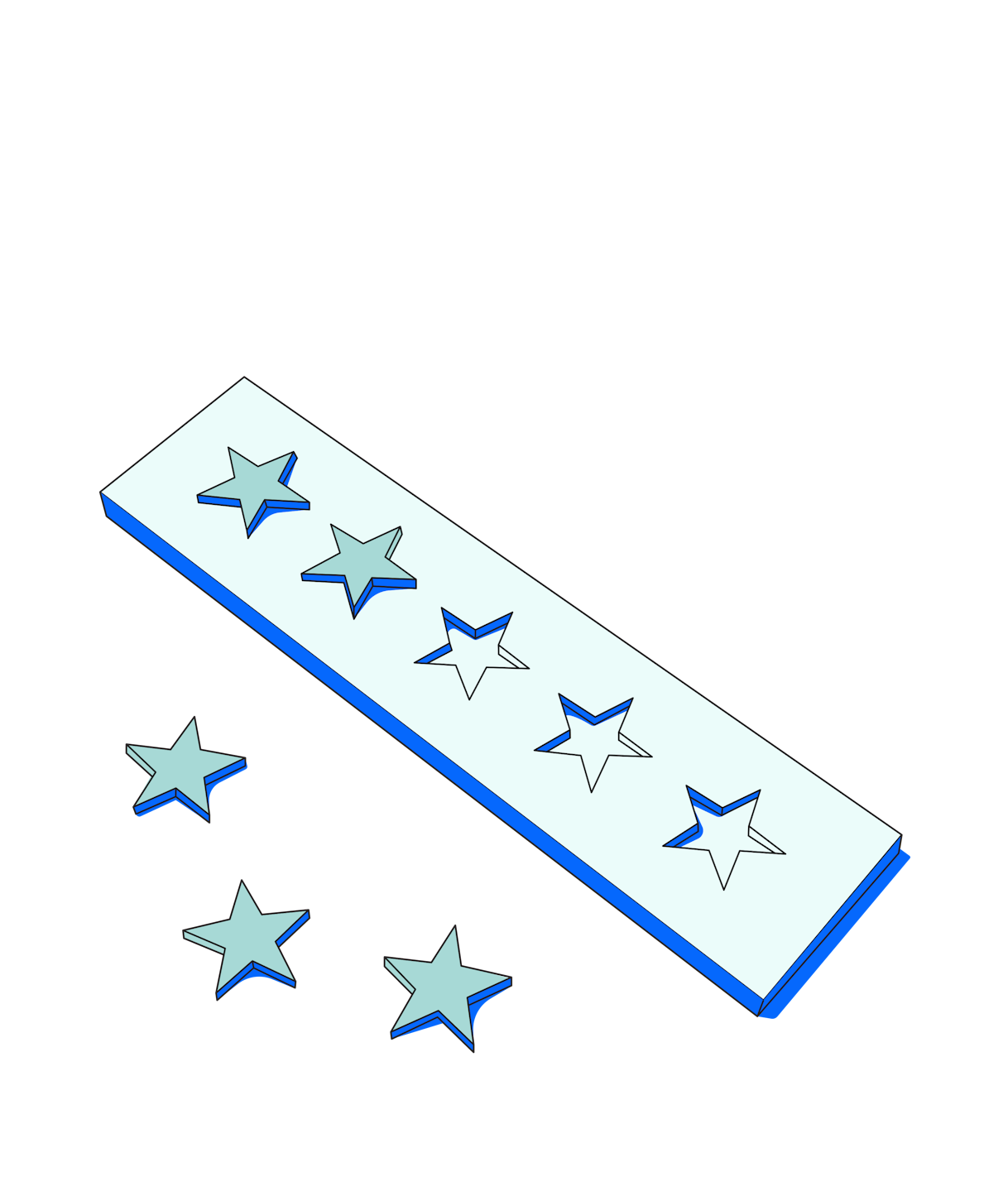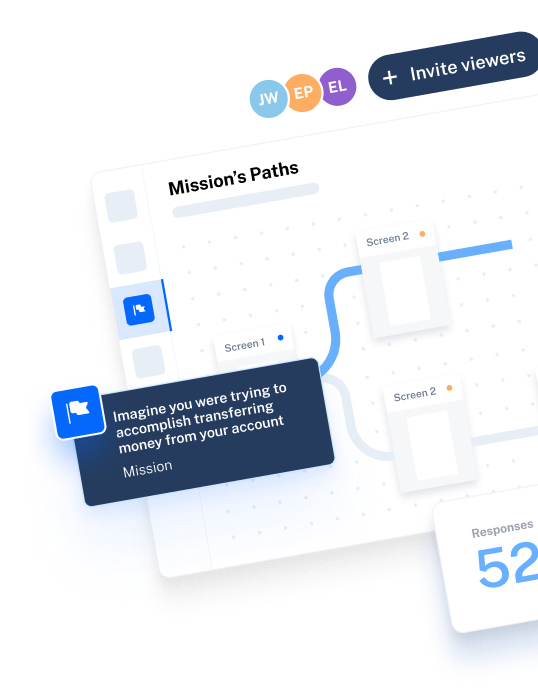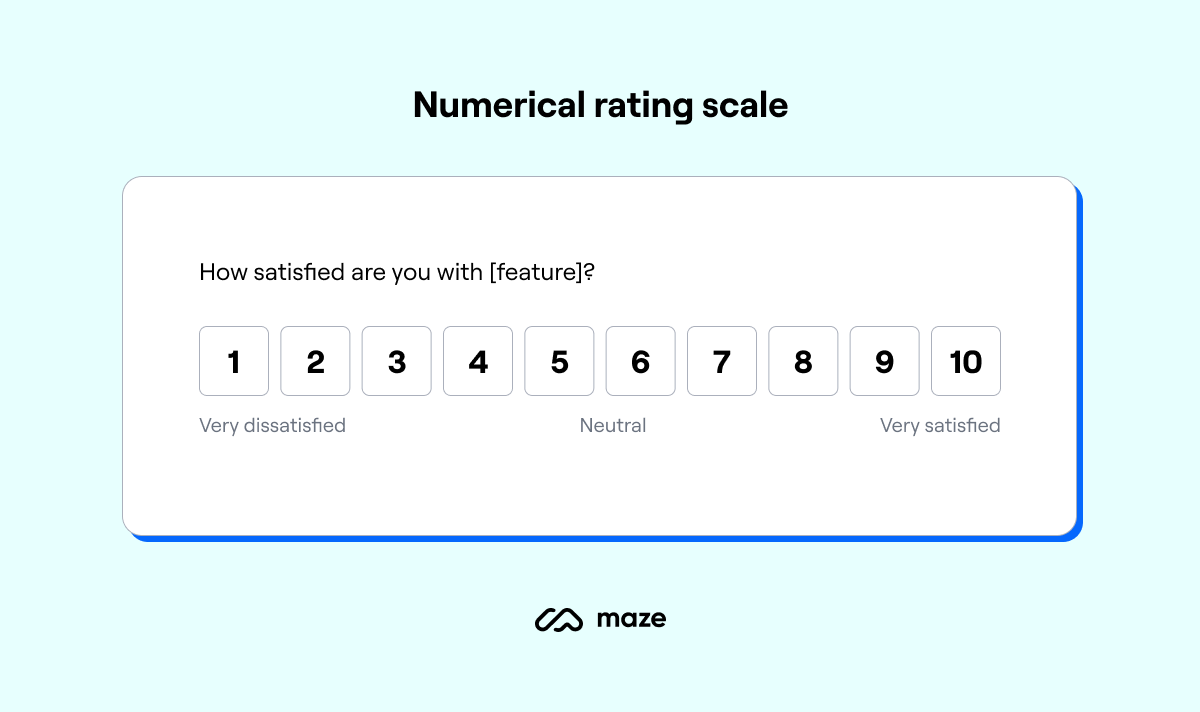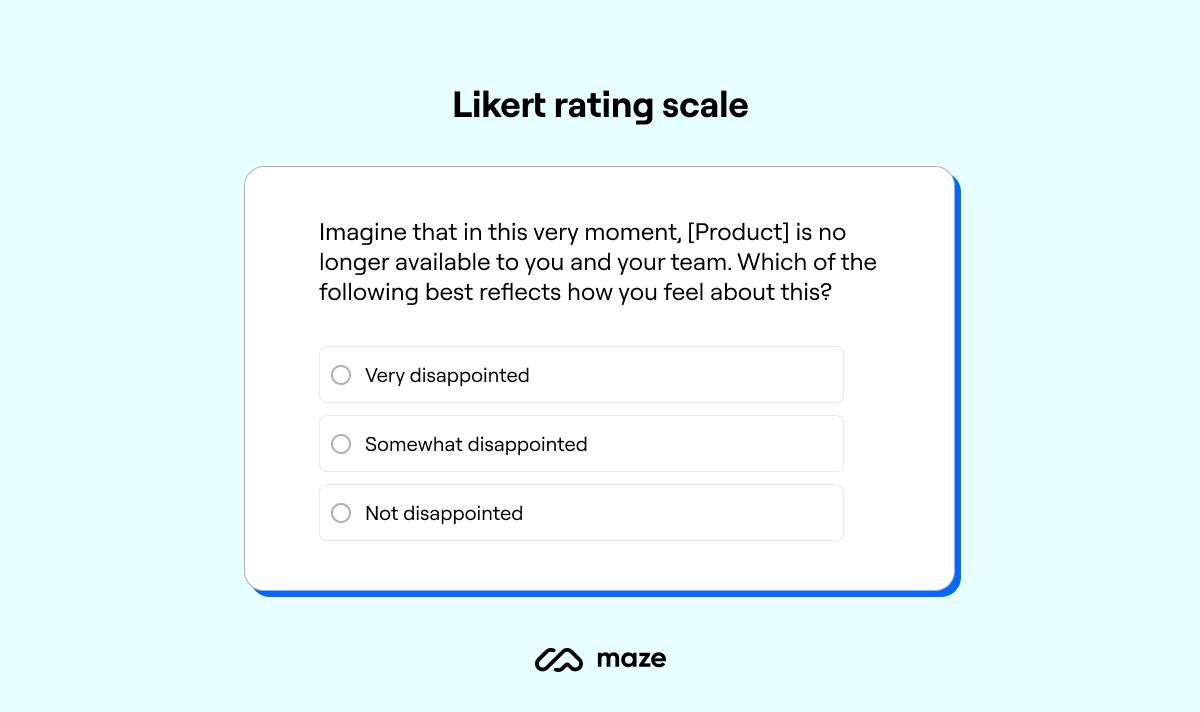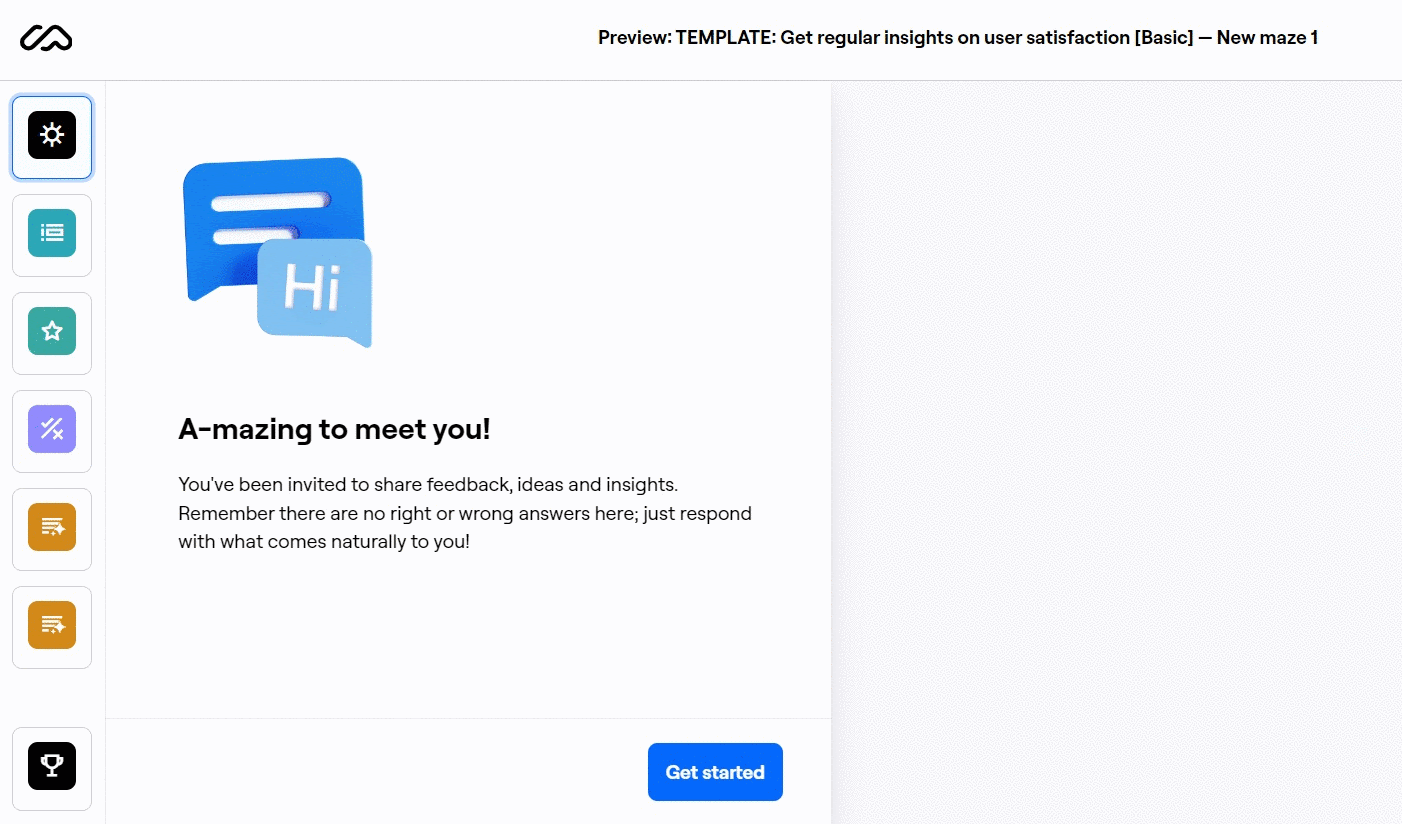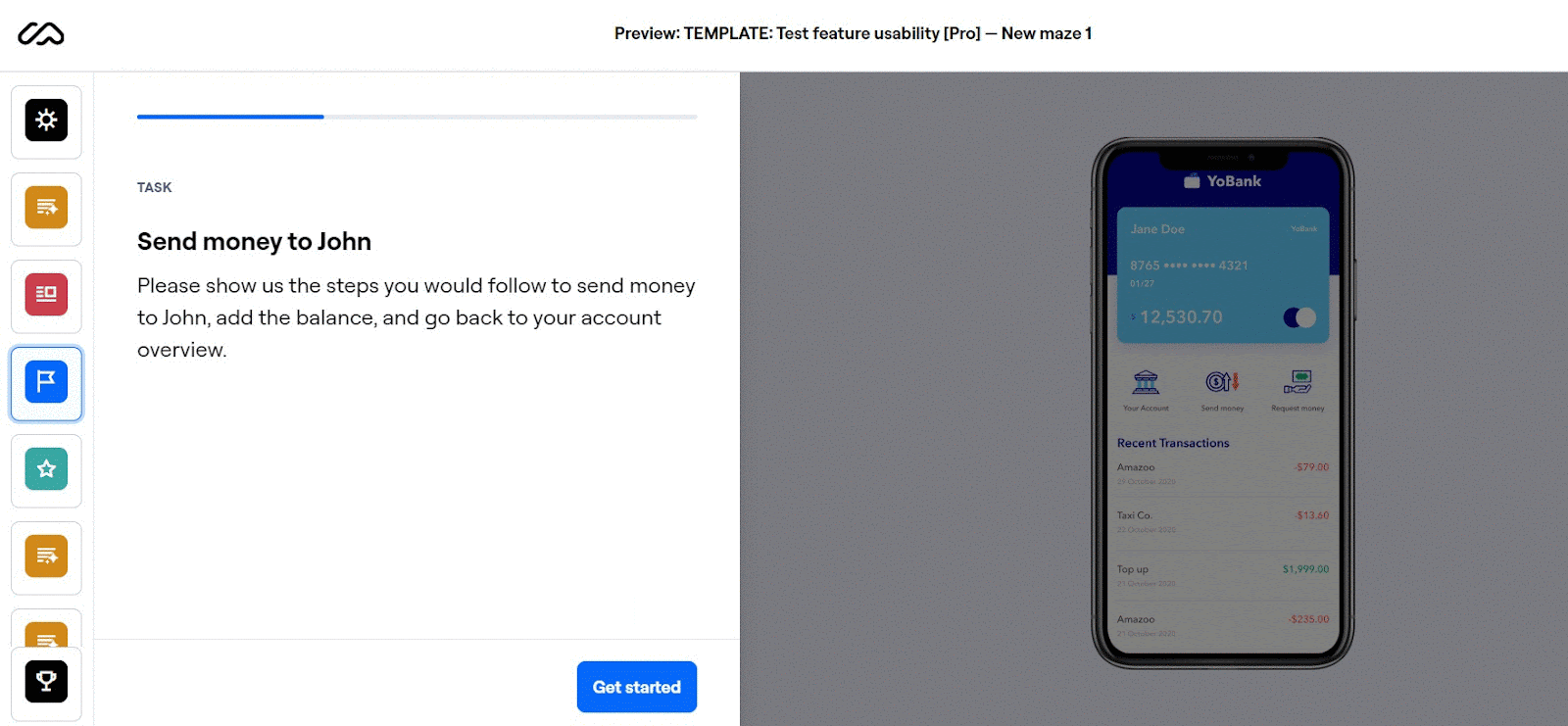Rating scales are one of the most popular survey techniques, blending the depth of sentiment and opinion-based insights with the efficiency of quantitative analysis.
Giving users multiple choices to convey their opinions about your product or ideas, rating scales can collect customer insights at scale to help you learn about user perspectives, behaviors, and preferences.
It’s quicker for users, and in turn it’s quicker for you.
Let’s look at the type of rating scale questions you can use in your surveys, and where best to use them for game-changing UX research.
What are rating scales?
A rating scale is a closed-ended, multiple-choice UX survey question where each answer carries a specific weight or value. Responders can choose from several answer options to explain how they feel about a product, idea, or statement.
Think of rating scale questions as a way to collect data for qualitative attributes (like feelings and perceptions) through quantifiable questions.
A common example of rating scale questions is when you make a purchase (online or offline), and brands ask you to rate your shopping experience.
Rating scales are versatile because you can choose from different types of questions to collect specific data. They’re a popular survey tool because they capture subjective sentiments, framed in a way that can be analyzed quantitatively.
You can use rating scale UX survey questions to conduct market research, collect customer insights, and make informed business decisions.
What are the types of rating scales?
Broadly, you can classify all types of rating scales within two categories: ordinal and interval scales.
- Ordinal scale: Collects data for non-mathematical ideas, like sentiments. You can label and rank data in a specific order but not necessarily understand the degree of difference.
- Interval scale: Organizes data in a defined numerical scale where you can find the exact difference between two or more variables.
Let’s break down eight popular types of questions you can use in a rating scale survey.
Numerical rating scale
Best for: Quick assessment and easy comparison
The numerical rating scale helps quantify different behaviors, emotions, and opinions. You can use numbers as response options and assign values on each end of the scale.
In numerical rating questions you can mention values to indicate what numbers on the left (1, 2, 3…) and right (8, 9, 10) mean. In this case, the values are 'very dissatisfied' and 'very satisfied'.
This type of rating scales provides quantitative data for easy comparison and analysis. It's best suited for use cases like customer satisfaction surveys and employee performance reviews.
Graphic rating scale
Best for: Engaging a diverse target audience where language barriers exist
The graphic rating scale replaces numbers with emojis, symbols, or images to make the questionnaire more visual and engaging. These surveys are also easier to interpret since respondents can quickly pick an option rather than thinking deeply about the values numbers indicate. You can choose to include labels on the left and right brackets or not.
Amazon presents a great example of this with its star-based rating scale. Customers can rate their satisfaction levels on a scale of 1-5 stars. You’ll also frequently see smiley face rating scales at visitor attractions, airports, and other public places.
A graphic rating scale is best suited for scenarios where you want a quick reaction. They’re also ideal when running a UX survey for a global audience, and you need to ensure there’s no language barrier. You can simply translate the questions and use universally understood graphics, like stars or emojis.
Descriptive rating scale
Best for: Qualitative and nuanced feedback for better context
The descriptive rating scale uses terms like good, better, excellent, or agree, strongly agree, and disagree as answer options for respondents to share more detailed feedback. This nuance also helps in conducting further research to understand why participants feel a certain way about your product or ideas.
This survey question type works well for product evaluations, quality checks, and performance reviews, as you can collect more qualitative data rather than only numbers. It’s also an ideal question type for an open follow-up question or text box to gather additional qualitative feedback.
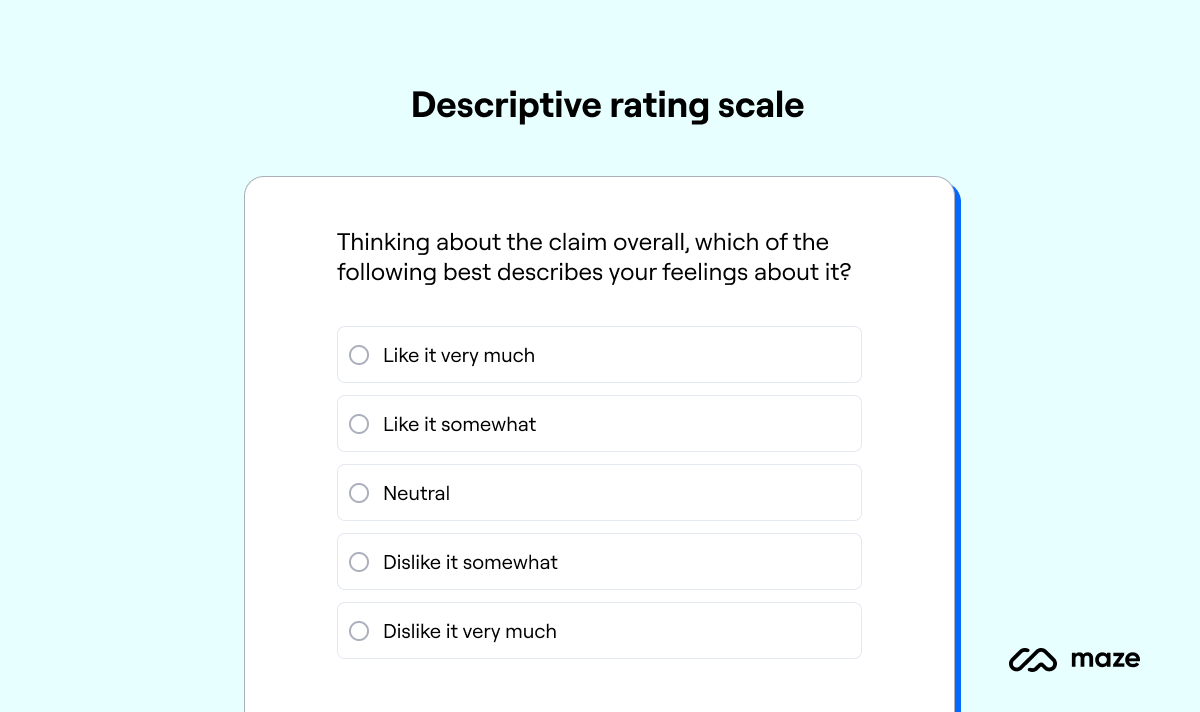
Descriptive rating scale from Maze
Comparative rating scale
Best for: Understanding user preferences to compare two or more options
The comparative rating scale is a type of matrix question that helps in benchmarking multiple choices. This could be two or more products, features, ideas, or anything worth comparing. This rating scale tool revealswhat your audience prefer and how these choices impact their decisions.
You can use comparative rating questions to compare your product against key competitors. Each question will give them multiple response options (this can be numerical values or descriptive ratings) for two or more ideas/products, like in this example.
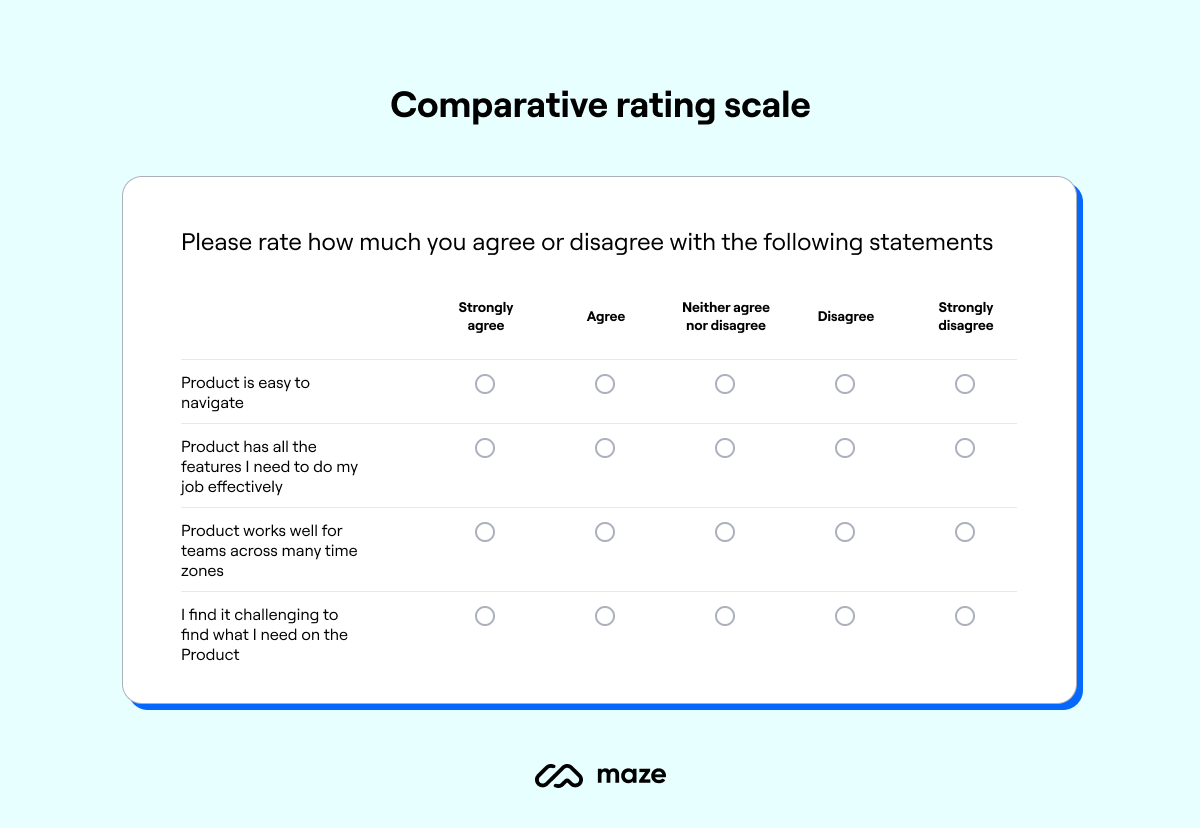
An example comparative rating scale
Comparative ratings are great for collecting user reactions to specific features. You can get a better idea of their primary feature preferences and plan your upcoming capabilities through strategic prioritization.
Likert rating scale
Best for: Subjective assessment to gauge people's perceptions of a topic
Likert rating scales present a series of statements where respondents choose to what degree they agree or disagree with a set of statements. These surveys usually include 5-7 response options between strongly agree and strongly disagree.
This methodology is widely used for customer satisfaction because it gives you an easy way to gather subjective data at scale. You can collect responses on a more detailed spectrum for various use cases, like evaluating the quality of customer experience.
Outside of UX research, it’s also used in social science research because it captures data about people’s attitudes and opinions on any subject.
Unlike other types of rating scale, Likert questions don’t have to adhere to a particular format or layout—they can appear as a scale from left to right, or be as simple as a multiple choice format. Here’s a Likert rating scale question from Maze’s product feedback survey template to collect user feedback about the product’s value:
Frequency ratings scale
Best for: Evaluating how common certain behaviors are and how they change over time
Frequency rating questions determine the frequency of certain behaviors and responses. You can include options like sometimes, often, rarely to understand how common/uncommon a particular type of behavior is.
This survey type is great for conducting longitudinal studies over time. You can identify patterns or changes in user behavior during a specific timeline.
For example, frequency rating questions will tell you how frequently people use feature A. You can survey users consistently to assess how this frequency has changed in the last few years.
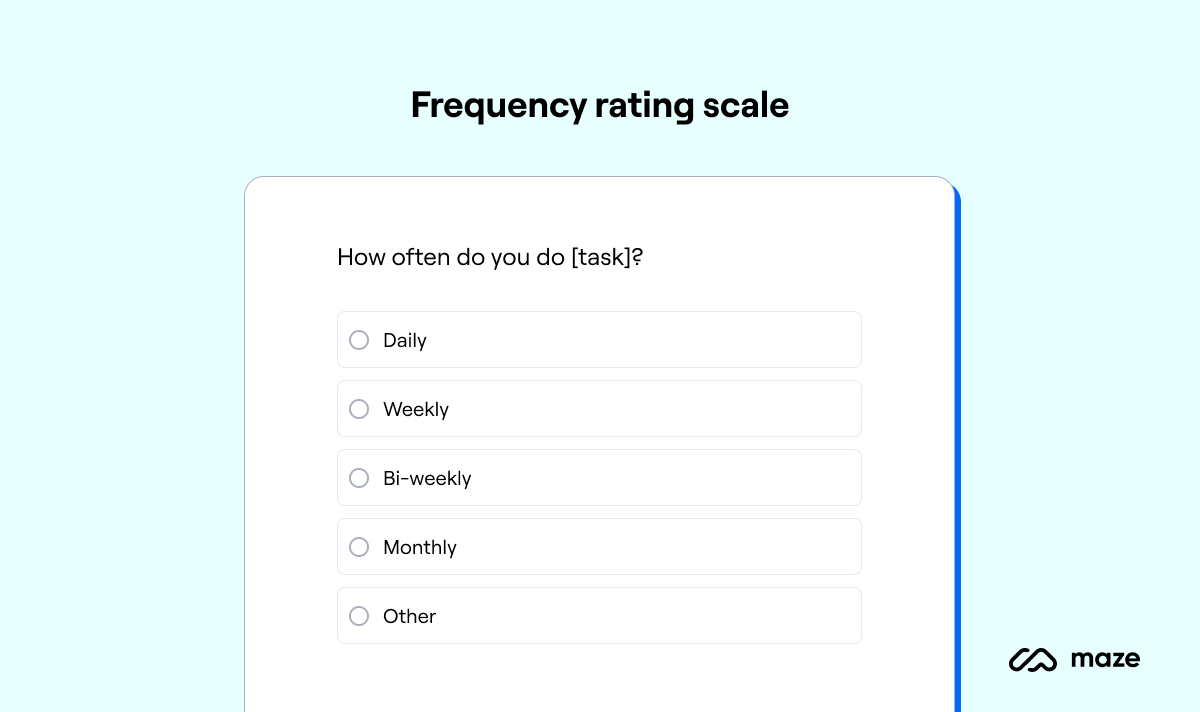
Frequency rating scale from Maze
Semantic-differential rating scale
Best for: Understanding nuanced perceptions about a product or concept
The semantic-differential scale asks respondents to rate a product or idea on a scale of adjectives between polar opposites, like effective–ineffective, good–bad, happy–sad. These questions can be labeled with words or points, like +3 and -3.
This survey tool is widely used to understand the perceived quality or impact of a product or brand. It can reveal subtle differences in people’s perceptions that might not be captured in other scales.
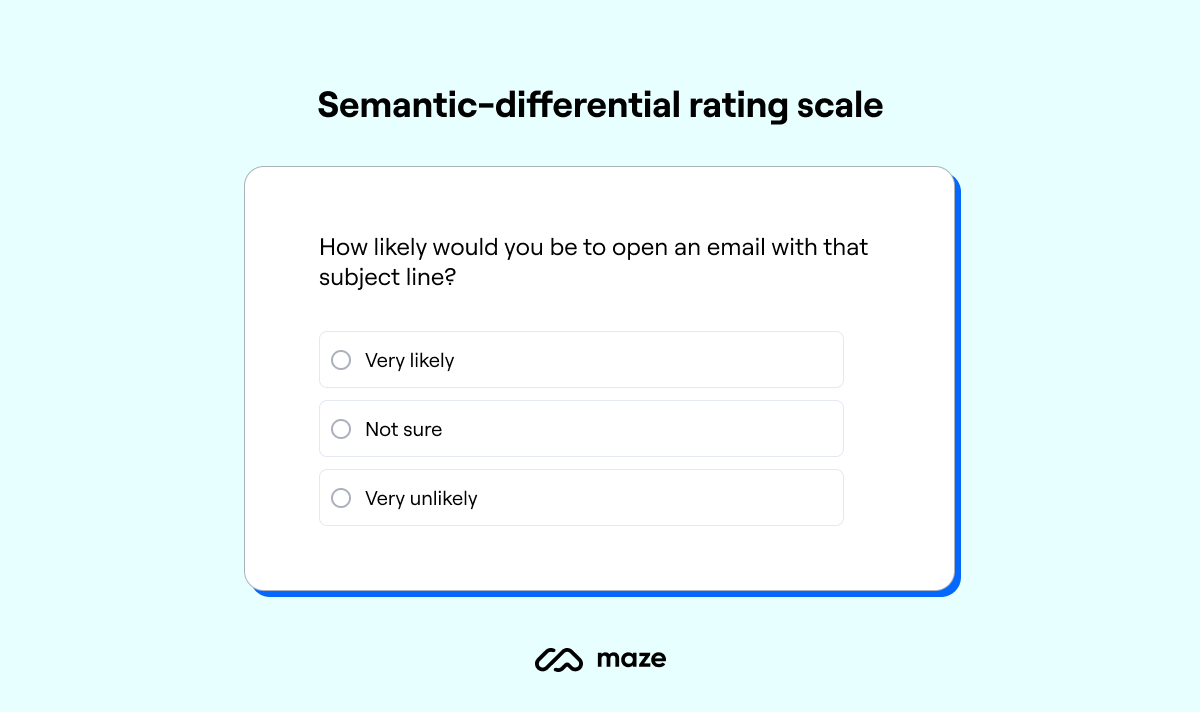
Semantic-differential rating scale from Maze
Slider rating scale
Best for: Engaging respondents through interactive data collection
The slider rating scale is an interactive tool where survey respondents can move a sliding marker to indicate their level of agreement or satisfaction. You can design this scale to be a set of numbers or qualities.
It’s a versatile survey method to engage participants and offer more flexibility in sharing responses. You can collect more granular data with this method as opposed to a traditional categorical scale. However, quantifying and measuring this data is difficult and more time-consuming.
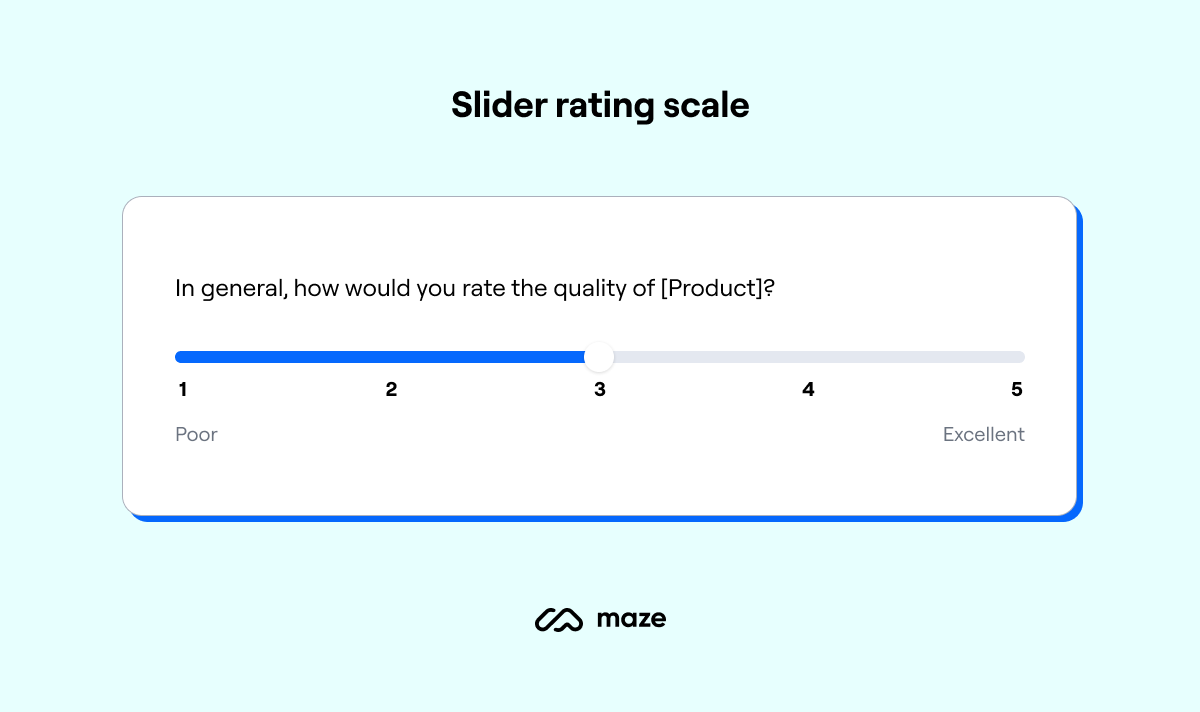
Slider rating scale from Maze
4 Rating scale examples in UX surveys
Scales are a versatile survey technique—here’s four common use cases for rating scale surveys in UX research, along with the kind of survey questions to ask.
💡 Looking for more rating scale examples? Check out the Maze Question Bank: a free-to-use question repository, with over 350 ready-to-go questions for UX research.
Net promoter score
Net Promoter Score (NPS) measures the likelihood of customers recommending your product to others. It's widely used as a metric of customer experience and customer loyalty, where users rate how likely they are to recommend your product to others.
You can use the numerical rating scale to create NPS questions, like this one from Maze’s NPS template.
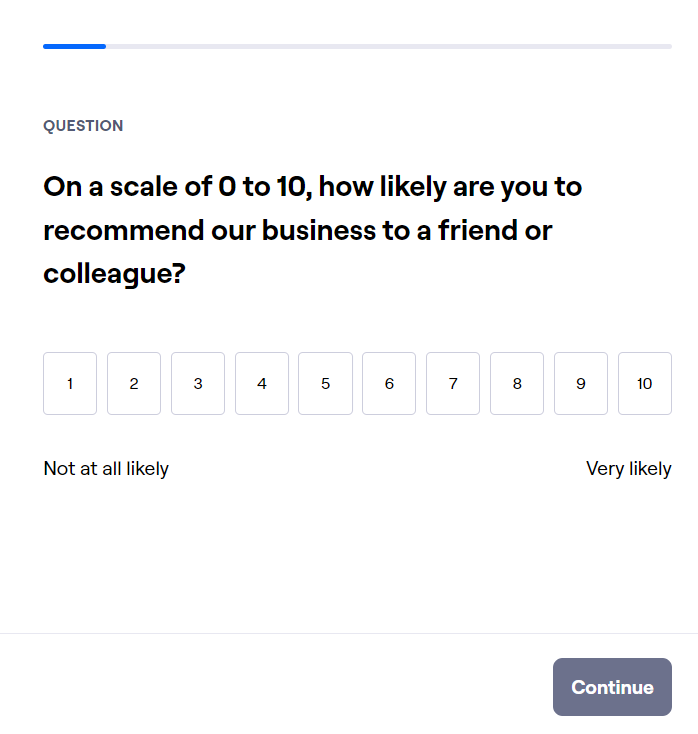
What’s more, you can also collect more concrete information by adding descriptive questions, like this one about feature usage.
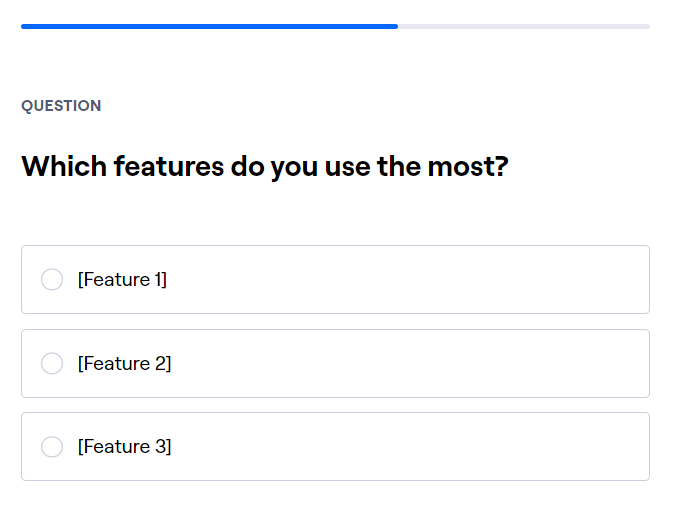
Once your study’s complete, use UX survey analysis to categorize users as:
- Promoters (9-10 score): your biggest product champions
- Passives (7-9 score): somewhat satisfied with the product
- Detractors (0-6 score): at risk of churning
NPS rating scale questions give you a clear indication of customer satisfaction, while also opening a chance for further research to identify what specifically is making customers happy/frustrated.
Customer satisfaction survey
Customer satisfaction surveys use a combination of different types of rating scales to get a pulse of your users’ sentiment.
You can make your surveys more meaningful and collect relevant data with a combination of these rating scales:
- Numerical scale: Best for asking users about their satisfaction with your product or brand. Define clear numerical scales for measuring different aspects of your customer experience, like ease of support, quality of self-serve help, and user interface.
- Descriptive scale: Best for zooming in on subjective details. Ask customers about which features they like or dislike the most. Expand your survey with open questions to collect the reasons behind their choices.
- Likert scale: Best for collecting feedback against specific parameters. Present statements related to your product with options between 'strongly agree' and 'strongly disagree' to see how they perceive your brand.
- Graphic scale: Best for micro-surveys to collect quick feedback in-the-moment. Check how users feel about a specific feature, tooltip, or help article within and outside your app.
- Frequency scale: Best for assessing feature/product usage. Evaluate how often customers use a specific function within your product to assess its value.
Here’s how Maze’s product satisfaction survey template combines multiple rating scale questions to collect well-rounded feedback:
Measuring customer satisfaction is a building block for product teams to create a more intuitive user experience. Plus, you can make these surveys as detailed or concise as you’d like with different rating scales and a variety of user research questions.
Customer effort score
Customer effort score measures the effort a user has to put in to get the best value for your product or troubleshoot issues. This survey typically uses the descriptive rating where you can define options on a scale of very easy to very difficult.
Alternatively, you can also use the graphic scales using star ratings or emojis to assess the effort required to navigate your product. Star ratings are fairly common in collecting feedback for support requests—which makes up one part of the effort score.
A descriptive scale makes it easier to calculate the overall customer effort score since you can easily quantify the results into different effort brackets.
Usability testing
Usability testing evaluates the ease of using your product. You can recruit participants to perform certain tasks within the product and rate the ease of performing the action.
Integrating a rating scale into your usability test is an easy way to gather additional data, without demanding much more effort from users.
Typically, user testing surveys include a numerical rating scale with values between very difficult and very easy to rank ease of use. You can also modify these values based on the parameter you want to test, like easily discoverable and not easily discoverable for testing feature discoverability.
Here’s an example of how you can combine a rating scale survey with usability testing using a Maze template:
Rating scale surveys: Pros and cons
Rating scale surveys give you a (excuse the pun) scalable way to collect user feedback and quantify sentiment-based feedback. But you can’t rely solely on rating scales to conduct user research—especially not when there’s a whole world of UX research methods out there. As with any research technique, rating scales are best used as one part of a wider research study with mixed methods.
So when do you know if rating scales are the right question technique? Let’s break down the key benefits of using rating scales for user and customer surveys. We’ll also discuss some of the times you might want to use an alternative technique.
Pro #1: They quantify diverse user opinions
Closed-ended questions tend to restrict the kind of data you can collect, but rating scales bring more diversity to the type of output you can collect and quantify.
Instead of a good/bad option, you can give users more choices—like an emoji scale or a descriptive rating—to accurately convey their opinions. This way, you have the speed and ease of closed-ended questions, with the freedom of more choices. Meaning you can easily quantify the responses into different buckets and get specific, actionable insights.
Pro #2: They facilitate comparison and analysis
Rating scales also help in product benchmarking and competitive product analysis. You can survey your target audience to understand how they perceive your product against competitors. Paired with a few subjective questions, these surveys can also tell you user priorities to guide your product roadmap.
What's more, you can use rating scales to compare which capabilities or jobs to be done matter more to your customers. It's essentially a way to learn about their preferences in an order of priority and make strategic decisions accordingly.
Pro #3: They’re a versatile data collection tool
Another huge advantage of using rating scales is their versatility. You can use these questions across the board for UX research—from idea validation and concept testing to feedback surveys and usability testing.
These questions are adaptable to the kind of data you want to collect. If it's purely quantitative, go for numerical ratings. But if you want more contextual perspectives, choose Likert or semantic scales.
Pro #4: They’re easy to design and understand
For researchers, rating scales are easier to design and interpret. For your respondents can quickly grasp and answer these questions while still capturing the nuance behind each answer.
With 50+ templates from Maze for various use cases like copy testing, concept validation, satisfaction surveys, and more, you never have to design a survey from scratch.
Unlike other research and survey methodologies, rating scales are more straightforward and more convenient to collect quantitative and qualitative data at scale.
So, that’s the pros—what about the cons of rating scale surveys?
Con #1: They can be susceptible to response biases
One of the biggest downsides of rating scales is the high chance of biased responses. Question-order bias and Gambler’s fallacy often present themselves in multiple-choice surveys. When it comes to rating scales, researchers typically face two specific types of cognitive biases:
- Acquiescence bias: Some respondents have a tendency to agree with statements regardless of their own viewpoint. They might be influenced by the phrasing of these sentences and unknowingly lean toward a positive or negative response. You can combat this by watching our for leading questions—like “On a scale of 1-10 how much has our product enhanced productivity for you?” which implies the product has enhanced productivity.
- Social desirability bias: People might be inclined to pick choices that will make them look good among others. This is common in non-anonymous surveys where respondents think more about how they’ll be viewed for their answers. For example, a question that asks existing users “Do you recommend our tool to your peers?” might nudge them to respond positively to avoid seeming rude.
Con #2: Lack of depth
While rating scale surveys can quantify qualitative attributes like sentiments and behaviors, they aren't as in-depth as other qualitative UX research methods like focus groups or 1:1 user interviews. There's less space for subjectivity, which leads to the loss of valuable insights.
Another factor is that respondents tend to rush through the questions without fully understanding the ask. This can compromise the integrity of your research data and produce misleading results. The result? Inaccurate insights that don’t reflect users’ true beliefs.
Luckily, this con has an easy fix: gather additional context and deeper insights by combining rating-based questions with open-ended ones. Alternatively, you can follow-up with specific individuals to learn more about their answers.
Con #3: Confusion due to scale variations
More advanced rating scale questions—like Likert and semantic-differential scales—can be confusing for respondents, as they have subtle differences in answer options that require critical thinking. The result: people misunderstand the question and end up giving false answers. This can lead to inaccurate responses and skew the research findings.
To mitigate the risk of user confusion, it’s worth sticking to one or two types of rating scale per survey, rather than trying to include them all.
Asking rating scale questions with Maze
Building rating scale surveys is as simple as a couple of clicks with Maze Surveys.
You can collect user data and feedback with different types of questions, including opinion scales, numerical ratings, open-ended questions, and more. Plus, Maze AI enables you to easily craft the Perfect Question and ask relevant Follow-Up Questions to ensure you’re gather additional depth on the insights you need.
You can also recruit participants directly through Maze Panel, and manage them with Maze Reach—to avoid juggling multiple tools and streamline your research operations.
Round off your research with custom, insight-packed reports to share with your team and stakeholders. What are you waiting for?
Frequently asked questions about rating scale
What are the types of rating scales?
What are the types of rating scales?
Here are eight popular types of rating scales:
- Numerical rating scale
- Graphic rating scale
- Descriptive rating scale
- Comparative rating scale
- Likert rating scale
- Frequency rating scale
- Semantic-differential rating scale
- Slider rating scale
What is a 4-point rating scale?
What is a 4-point rating scale?
A 4-point rating scale gives participants four options to choose from. These options are typically about the degree to which they agree or disagree with a statement or idea.



